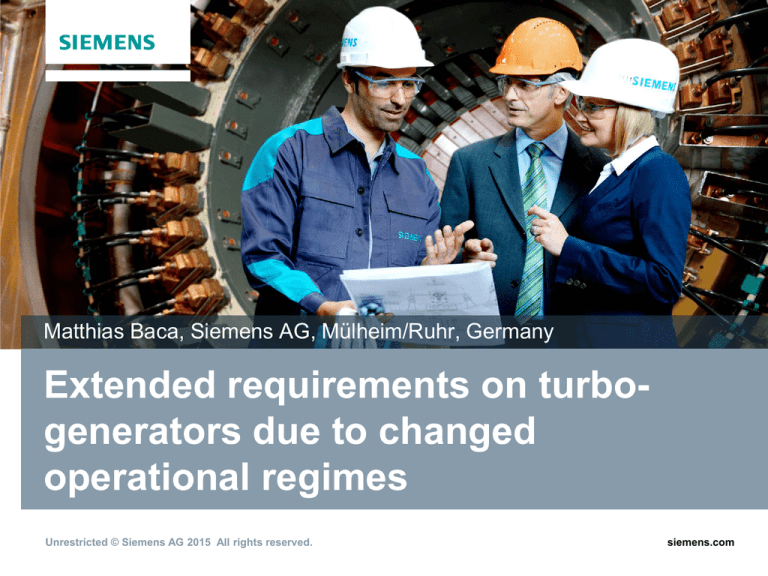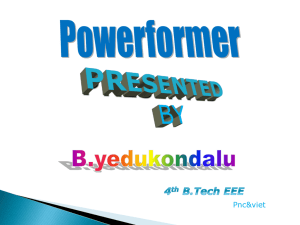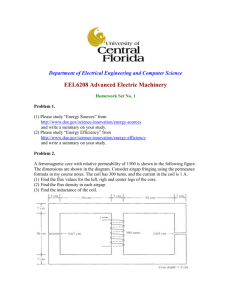
Matthias Baca, Siemens AG, Mülheim/Ruhr, Germany
Extended requirements on turbogenerators due to changed
operational regimes
Unrestricted © Siemens AG 2015 All rights reserved.
siemens.com
Table of Content
• Evaluation of current operation
regimes
• Extended requirements on turbogenerators
Fast active & reactive load changes
Load ramps
Under-excitation
Over-voltage
• Possible Solutions and
Mitigations
• Conclusions
Unrestricted © Siemens AG 2015 All rights reserved.
Page 2
September 2015
VGB Congress
AL:N; ECCN:N
Matthias Baca
Evaluation of Operation Regimes
Air Cooled Generators, 300 MVA Class
Relative frequency of operation point (P, Q) [%]
Distribution of reactive power
operation of all 33 units
over-excitation under-excitation
Worldwide disposition of the generators in the 50 Hz market
Detailed evaluation from commissioning up to 2014
Strong dependency on renewable share and grid connection
Increasingly frequent permanent load fluctuations
•
•
•
•
Summarized load capability
diagram of the investigated
>
generator fleet
with relative
frequency of operation points
High number of start-stop cycles
in % of all units
Operation in whole released capability range
High
share
of reactive
power for grid stabilization
active
power
Full use of under-excitation capability because of capacitive grid demands
Variable
and specific
Increased
demandoperation
on highlystresses
flexible for
generators
of the same power
class plants
load operation
of conventional
Generator Nr.
reactive power
One
specific
generator
33
32
31
30
29
28
27
26
25
24
23
22
21
20
19
18
17
16
15
14
13
12
11
10
9
8
7
6
5
4
3
2
1
mean 20%
mean 80%
Unrestricted © Siemens AG 2015 All rights reserved.
Page 3
September 2015
VGB Congress
AL:N; ECCN:N
Matthias Baca
Extended requirements on turbo-generators
Overview
Increased requirements
Fast active & reactive
load changes
High
thermomechanical
tension at windings
Load ramps up to 24 % of
rated MW / min
Thermal cycling
Under-excitation
High magnetic flux in
end region
Over-voltage
Expected strain in respect to cooling method
Indirectly Directly
Generator components
cooled
cooled
Physical / technical
challenges
High magnetic flux
density
Main bushings of stator winding
Mid
Low
Carbon brushes and slip rings of static
excitation
Low
Low
Stator core end zones (stepped teeth)
Mid
Low
Stator winding, especially overhangs
High
Low
Rotor winding, especially end-windings
covered by retaining rings
High
Mid
Complete stator winding
High
Low
Complete rotor winding
High
Low
End teeth, press finger, press plate
High
Mid
Stator winding in stepped core area
High
Low
Stacking beams at stator core back
High
High
Rotor winding
High
Mid
Stator core insulation
Low
Low
Unrestricted © Siemens AG 2015 All rights reserved.
Page 4
September 2015
VGB Congress
AL:N; ECCN:N
Matthias Baca
Fast active & reactive load changes, ramps
Thermo-mechanical stress on the stator winding insulation system
ΔP in MW or ΔQ in Mvar alteration of stator current ΔIRST alteration of stator
winding losses (ΔPV ~ ΔIRST2) change of stator winding temperature (ΔT ~ ΔPV)
Positive load change
+ ΔP, ΔQ
Stator winding bar
Insulation
T
T
Copper
conductor
Generic cyclic
Negative load change thermo-mechanical loading
- ΔP, ΔQ
Insulation
Copper
condctor
September 2015
Generator Nr.1:
High amount of steep
current ramps
Steepness of current ramp
Unrestricted © Siemens AG 2015 All rights reserved.
Page 5
Rel. occurrence of current ramp ΔIRST/Δt [%]
Physical effect: Thermo mechanical stresses on the insulation system due to
• Different thermal expansion coefficients of copper, insulation and steel
• Different temperature levels
VGB Congress
AL:N; ECCN:N
Matthias Baca
Fast active & reactive load changes, ramps
stator core
Detailed evaluation of thermo-mechanical stress on the stator
winding insulation system
High thermo-mechanical
stress at first bend
• Challenging effort of „large“ end winding geometry compared
to thin/tiny insulation sleeve geometry
• Detailed knowledge about temperature dependent mechanical
properties of insulation materials
stator core
• Individual modeling of stator bar design including copper
conductor, insulation sleeve and interface
• Validation by strain and deflection measurements in operation
behaviour, continous calibration of design tools
Detailed assessment of highly stresses areas during load transients
Unrestricted © Siemens AG 2015 All rights reserved.
Page 6
September 2015
VGB Congress
AL:N; ECCN:N
Matthias Baca
Fast active & reactive load changes, ramps
Indirect cooled stator winding, inner/outer corona protection
Design characteristics of GVPI insulation system
Copper strands
Verification of designed
shear plane (ICP) by
detailed material tests
Designed shear planes (ICP/OCP) reduce thermo
mechanical stresses on groundwall insulation
Unrestricted © Siemens AG 2015 All rights reserved.
Page 7
September 2015
VGB Congress
AL:N; ECCN:N
Matthias Baca
Over-Voltage / Under-excitation / Start-stop cycles
Stator Core, Generator Rotor
Generator Rotor
Stator Core
• Risk of magnetic over-fluxing @ increased
voltage and frequency fluctuation
• Capability to maintain leakage flux and
circulating currents at the back of the core
• Mechanical integrity covered by extended
analysis:
LCF (start-stop cycles)
Wider grid frequency range (natural
frequencies)
Transient events
• Fast and frequent thermo cycling at the rotor
winding:
Taken from: IEEE-PES2012_WG8-Panelpaper_Grid Code Impact
to Machine-design
Equal temperature distribution in the
winding, no significant hot spots
Winding design allows fast thermal
expansion and contraction of copper
Insulation materials are designed to sustain
cyclic stresses for long term operation
• Under-excitation impact on end zone
All requirements must be considered in the design work
Unrestricted © Siemens AG 2015 All rights reserved.
Page 8
September 2015
VGB Congress
AL:N; ECCN:N
Matthias Baca
Possible Solutions and Mitigations
Fast active & reactive load changes, ramps
Power S, Temperature T
Variation of stator winding Temperature with
conventional cooling system
Generator Cooler
Stator winding temperature,
e.g. slot RTD
Generator Load
Time t
Simple Cooling Water System
without active regulation
Conventional static generator cooling system results in high variation
gradient of winding temperature and thermo-mechanical stresses
Unrestricted © Siemens AG 2015 All rights reserved.
Page 9
September 2015
VGB Congress
AL:N; ECCN:N
Matthias Baca
Fast active & reactive load changes, ramps
Enhanced temperature control system
Power S, Temperature T
Less variation of stator winding temperature with load change
Stator winding temperature
(slot RTD) with an active
operating control loop
Generator Load
Smoothing of temperature
variation higher T level
Schematic diagram of active
controlled generator cooling system
Controller
Process variable input
e.g. slot RTD, warm gas
Time t
Dynamic control of cooling gas temperature with new water cooler system
Reduced thermo-mechanical stress in winding materials
Unrestricted © Siemens AG 2015 All rights reserved.
Page 10
September 2015
VGB Congress
AL:N; ECCN:N
Matthias Baca
Possible Solutions and Mitigations
Under-excitation / Radial flux effect
Flat stator core end region
reduces “flux heating” in copper
strands in over-excited
operation mode (lagging p.f.)
High magnetic flux in
stepped core end
r-axis
stator core
top coil
optimal design
optimal design
meets future
extended
requirements
optimal design
Indirectly cooled stator
winding requires a
compromise to stay within
temperature limits of
• stator coil
• stepped iron
rotor
Steep stator core end region
reduces heating in stepped iron
in under-excited operation mode
(leading p.f.)
Best design to meet extended requirements:
Directly water cooled stator winding design
Steep stator core end region
Unrestricted © Siemens AG 2015 All rights reserved.
Page 11
September 2015
VGB Congress
AL:N; ECCN:N
Matthias Baca
Possible Solutions and Mitigations
Product life cycle philosophy, future targets
Power plant process
Optimization
Improved process of plants
Monitoring & Diagnostics
Continous data assessment
Condition & Fleet
experience based
maintenance concept
Flexible inspection schedule
Specific retrofit recommendation
Probability to failure
Life cycle assessment
Aging of components
Risk evaluation
Dynamic counter
Robust Product Design
Engineer toolbox
Validation process
Fleet experience
Low
Contingency risk
XXX
XXX
XXX
XXX
XXX
High
Rotor
Stator Winding
Unrestricted © Siemens AG 2015 All rights reserved.
Page 12
September 2015
VGB Congress
AL:N; ECCN:N
Matthias Baca
Condition Based Maintenance Future Goal
Example stator winding
1
Kind of loading
Measurement
Analysis
Aging effect
Thermo-mechanical
loading
Stator current, Cold gas temp Static forces,
strains
Debonding effects,
loosening support structure
Dynamic vibration load
Fiber optic vibration
Dynamic forces
measurement at end windings
Loosening end winding
structure
Electrical field load
Partial discharge
Pattern comparison Degradation HV-insulation
Transients during
All electrical data
electrical fault operation
Short circuit forces, Coil insulation at core end
strains
High thermo-mechanical load at slot exit
Risk
assessment
stator winding
1
Low
Contingency risk
High
Stator winding
Unrestricted © Siemens AG 2015 All rights reserved.
Page 13
September 2015
VGB Congress
AL:N; ECCN:N
Matthias Baca
Condition Based Maintenance Future Goal
Example stator winding
2
Kind of stressing
Measurement
Thermo-mechanical stress
Stator current, Cold gas temp Static forces, Cracks in the HVstrains
insulation material
Dynamic vibration load
Fiber optic vibration
Dynamic
measurement of end windings forces
Loosening end winding
structure
Electrical field load
Partial discharge
Degradation HV-insulation
Transients during electrical All electrical data
fault operation
Analysis
Pattern
comparison
Short circuit
forces
Aging effect
Coil insulation at core end
Harmonic Stator End Winding Analysis
Risk
assessment
stator winding
2
Low
Contingency risk
High
Stator winding
Unrestricted © Siemens AG 2015 All rights reserved.
Page 14
September 2015
VGB Congress
AL:N; ECCN:N
Matthias Baca
Condition Based Maintenance Future Goal
Example stator winding
3
Kind of stressing
Measurement
Analysis
Thermo-mechanical stress
Stator current, Cold gas temp Static forces, Cracks in the HVstrains
insulation material
Dynamic vibration load
Fiber optic vibration
Dynamic
measurement of end windings forces
Loosening end winding
structure
Partial discharge
tanδ0 values, Δtanδ0 rise
Degradation HV-insulation
and grading system
Coil insulation at core end
Transients during electrical All electrical data
fault operation
Pattern
comparison
Short circuit
forces
Aging effect
Partial discharge measurement of HV winding insulation
Risk
assessment
stator winding
aged
3
new
Low
Contingency risk
High
Stator winding
Unrestricted © Siemens AG 2015 All rights reserved.
Page 15
September 2015
VGB Congress
AL:N; ECCN:N
Matthias Baca
Condition Based Maintenance Future Goal
Example stator winding
4
Kind of stressing
Measurement
Thermo-mechanical stress
Stator current, Cold gas temp Static forces, Cracks in the HVstrains
insulation material
Dynamic vibration load
Fiber optic vibration
Dynamic
measurement of end windings forces
Loosening end winding
structure
Electrical field load
Partial discharge
Degradation HV-insulation
Transients during electrical All electrical data
fault operation
Analysis
Pattern
comparison
Short circuit
forces
Aging effect
Coil insulation at core end
Transient Analysis of Fault conditions
Risk
assessment
stator winding
4
Low
Contingency risk
High
Stator winding
Unrestricted © Siemens AG 2015 All rights reserved.
Page 16
September 2015
VGB Congress
AL:N; ECCN:N
Matthias Baca
Extended requirements on turbo-generators
Conclusions
New flexible grid demand has impact on whole system „generator“ with
different amount of wear and aging at individual components
Changed requirements and remaining uncertainty for future increase of
flexibility must be considered in the current generator development programs
Thermo-mechanical stresses on generator components require enhanced
load dependent cooling technology, particularly at the stator winding
Based on new EOH calculation with load change factor (VGB R 167 – 2010)
condition based maintenance is needed – new economic maintenance
strategies for the generator
Thank you for your Attention!
Unrestricted © Siemens AG 2015 All rights reserved.
Page 17
September 2015
VGB Congress
AL:N; ECCN:N
Matthias Baca
Extended requirements on turbo-generators due to
changed operational regimes
Contact page
Matthias Baca
Phone: +49 (208) 456 8222
Mobile: +49 (174) 1534169
E-mail: matthias.baca@siemens.com
Rheinstr. 100
45478 Mülheim an der Ruhr
Germany
Unrestricted © Siemens AG 2015 All rights reserved.
Page 18
September 2015
VGB Congress
AL:N; ECCN:N
Matthias Baca
Disclaimer
This document contains forward-looking statements and information – that is, statements related to future, not past,
events. These statements may be identified either orally or in writing by words as “expects”, “anticipates”, “intends”,
“plans”, “believes”, “seeks”, “estimates”, “will” or words of similar meaning. Such statements are based on our current
expectations and certain assumptions, and are, therefore, subject to certain risks and uncertainties. A variety of factors,
many of which are beyond Siemens’ control, affect its operations, performance, business strategy and results and could
cause the actual results, performance or achievements of Siemens worldwide to be materially different from any future
results, performance or achievements that may be expressed or implied by such forward-looking statements. For us,
particular uncertainties arise, among others, from changes in general economic and business conditions, changes in
currency exchange rates and interest rates, introduction of competing products or technologies by other companies,
lack of acceptance of new products or services by customers targeted by Siemens worldwide, changes in business
strategy and various other factors. More detailed information about certain of these factors is contained in Siemens’
filings with the SEC, which are available on the Siemens website, www.siemens.com and on the SEC’s website,
www.sec.gov. Should one or more of these risks or uncertainties materialize, or should underlying assumptions prove
incorrect, actual results may vary materially from those described in the relevant forward-looking statement as
anticipated, believed, estimated, expected, intended, planned or projected. Siemens does not intend or assume any
obligation to update or revise these forward-looking statements in light of developments which differ from those
anticipated.
Trademarks mentioned in this document are the property of Siemens AG, it's affiliates or their respective owners.
Unrestricted © Siemens AG 2015 All rights reserved.
Page 19
September 2015
VGB Congress
AL:N; ECCN:N
Matthias Baca



![FORM NO. 157 [See rule 331] COMPANIES ACT. 1956 Members](http://s3.studylib.net/store/data/008659599_1-2c9a22f370f2c285423bce1fc3cf3305-300x300.png)

